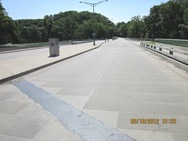
Underlying the current discussion of speed cameras is the assumption that speed limits are rationally set, presumably by expert traffic engineers and safety officials. This assumption isn’t necessarily valid, and a speed camera set up in conjunction with an irrationally low speed limit will be a problem.
The principal guide for setting a rational speed limit is the 85th-percentile speed of traffic. On “the theory that the large majority of drivers are reasonable and prudent, [and] do not want to be involved in a crash,” the speed limit is “generally set at the nearest 5-mph increment at or below the 85th percentile speed.” (See the 2006 DDOT Speed Study.)
Are there exceptions to this guideline? Yes, “an agency may choose, on the basis of one or more of these data” — that is, accident or crash histories for the location — “to post a speed limit that is slightly lower than the 85th percentile.” [emphasis added]
Now, an example, namely Porter Street/Klingle Road between Cleveland Park and Mount Pleasant. This looks like a bit of interstate highway plunked down in the middle of the city, evidence of a long-forgotten plan to make Piney Branch Parkway into an inner-city crosstown highway. It’s a four-lane divided roadway, limited access, no residences, no businesses, no crosswalks, no cross traffic, and it’s no wonder that drivers speed up at this point, not because they’re crazy speedsters, but because the road is clearly built for higher speeds.
The 85th-percentile speed for this road is 41 mph, as indicated by the 2006 Speed Study Map. Hence, the speed limit should be 40 mph, or maybe, if we’re being conservative, 35 mph. But in actual fact, the posted limit is 30 mph, which is more than “slightly lower” than the 85th percentile. It comes as no surprise that the speed camera placed at this location has been a bountiful source of speeding tickets. The MPD belatedly argues that “there is a lot of pedestrian and bicycle traffic accessing the park” here. But there’s no bike lane, no sidewalk on the north side (“Pedestrians Prohibited” is posted), and the sidewalk on the south side is virtually covered by vegetation. These are indications that pedestrian access is, to say the least, discouraged. As for bicyclists, as one of that tribe, I can say that this is one of the most bicycle-hostile locations in the city, and not because of traffic speed, but because of road design.
So, is the 30 mph speed limit appropriate? There’s no apparent justification for such a large deviation from the 85th percentile speed. In fact, just to the west of this location there are apartment houses and parked cars and driveways, and traffic speed there might be expected to be a greater concern than down where this “highway” opens up. But that’s not where the speed camera is pointed, suggesting that the MPD is not really interested in the safety of residents, but in issuing lots of $125 speeding tickets.
The speed camera wouldn’t matter if the speed limit were reasonable. Nobody can complain about a ticket for going much over the 85th percentile speed. The problem is not the speed camera, but the unreasonable speed limit, such that that 85th-percentile driver would, in this case, be exceeding the posted limit by a solid 11 mph.
So one has to wonder about other speed-camera locations in the District. The question is not the speed camera, but the appropriateness of the speed limit where the camera is located. Anyone defending a speed camera at a certain location should begin by confirming that the speed limit at that location is reasonable.
Top image: Porter Street. Photo by the author.
